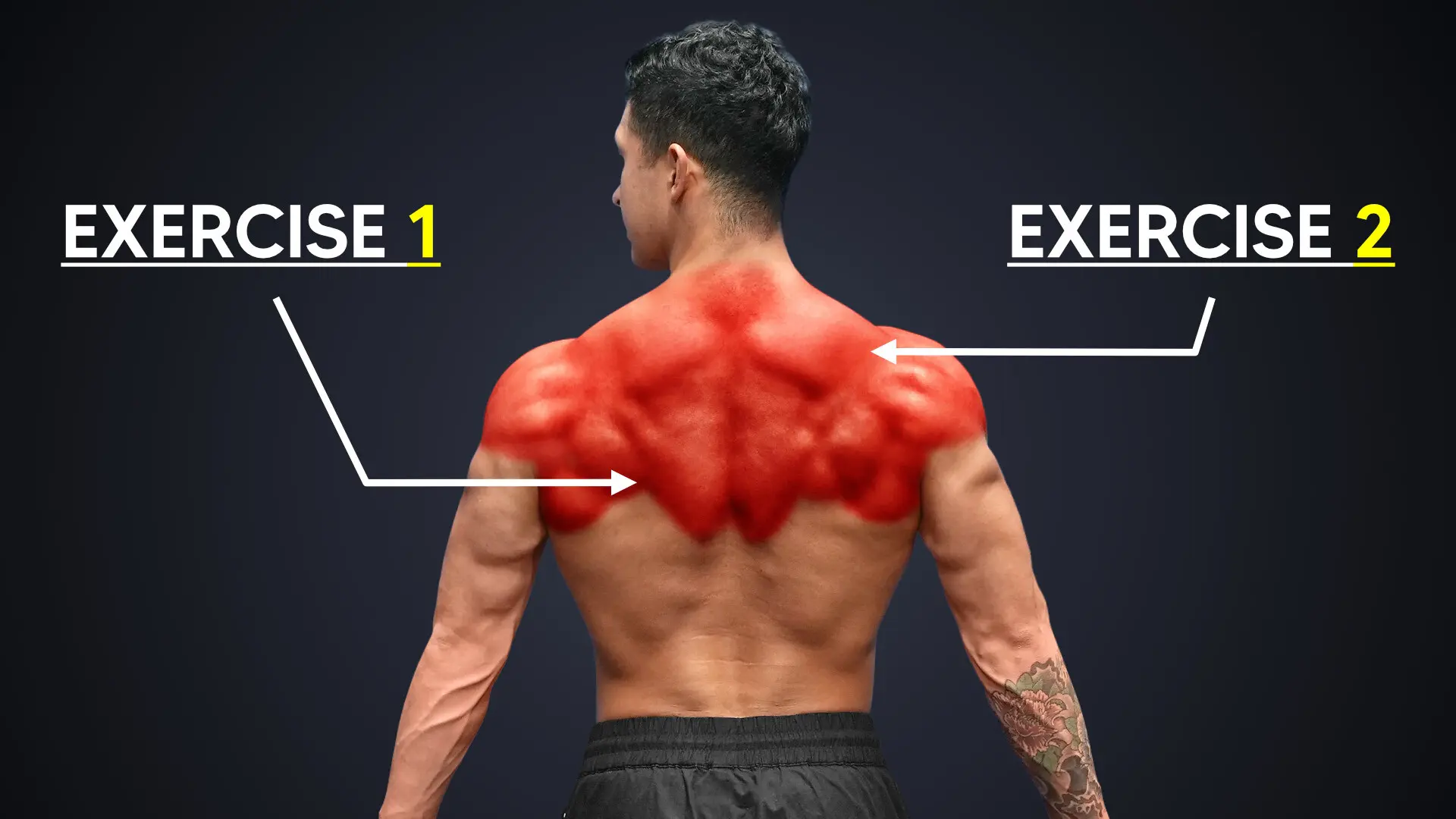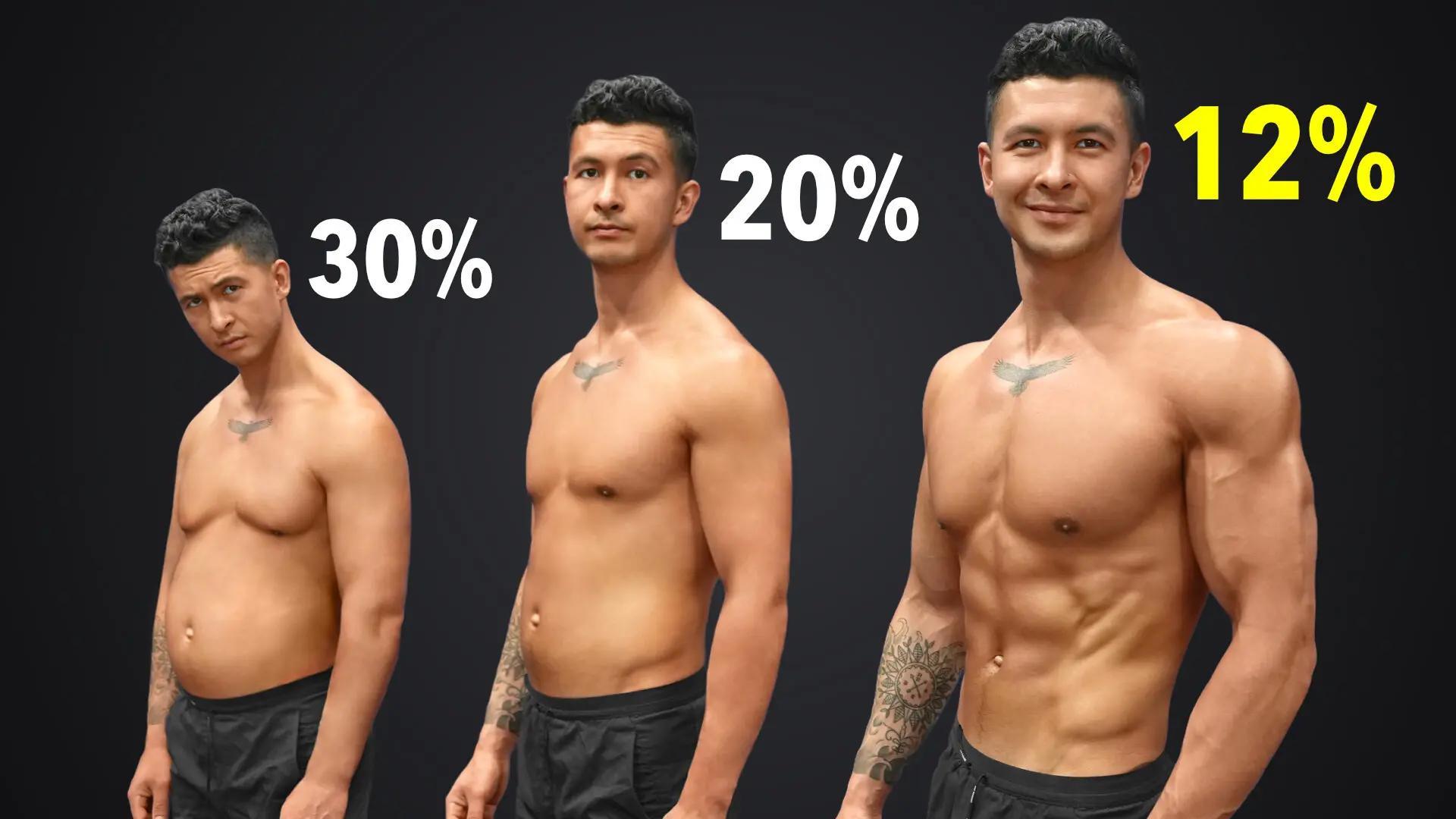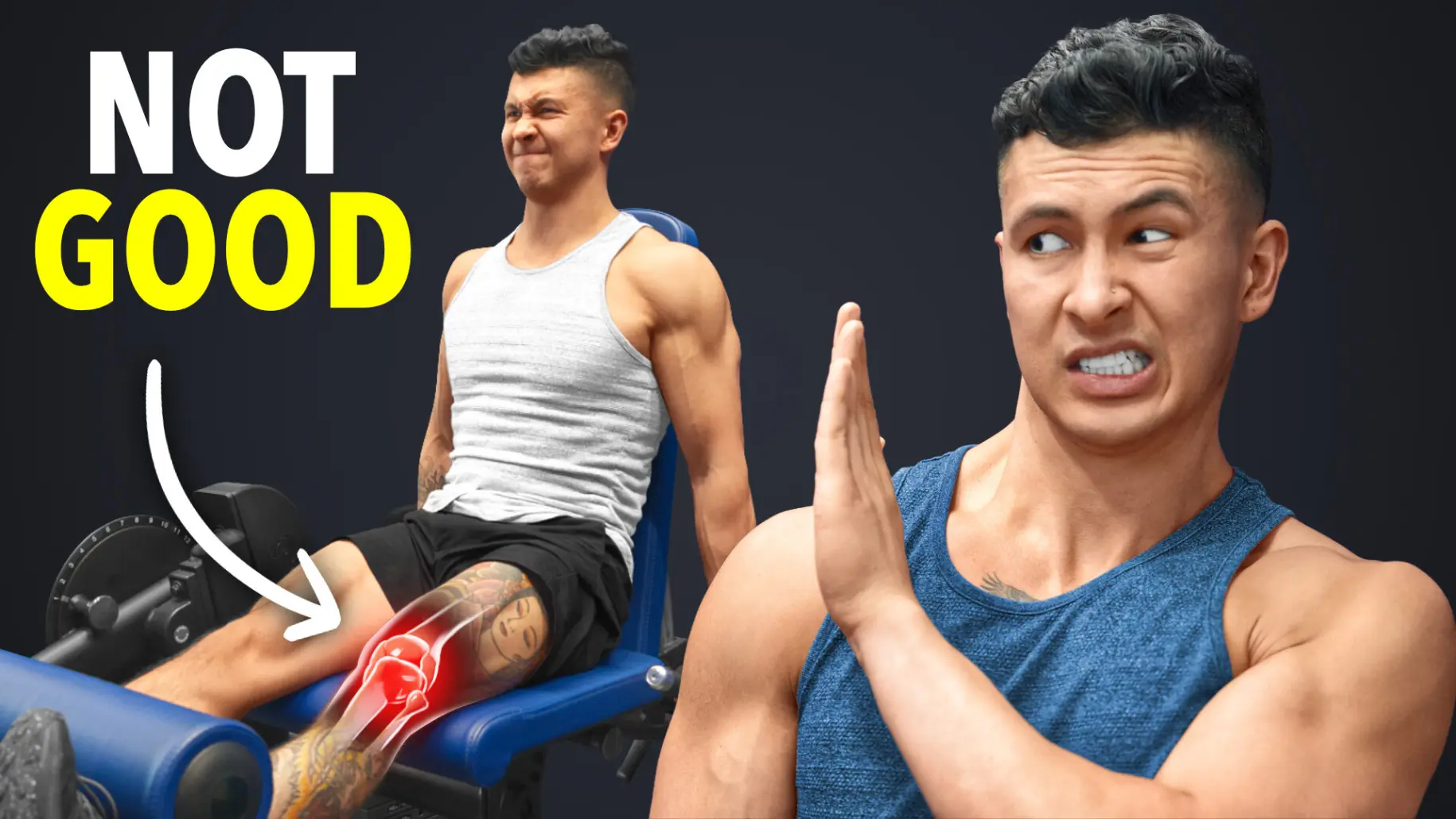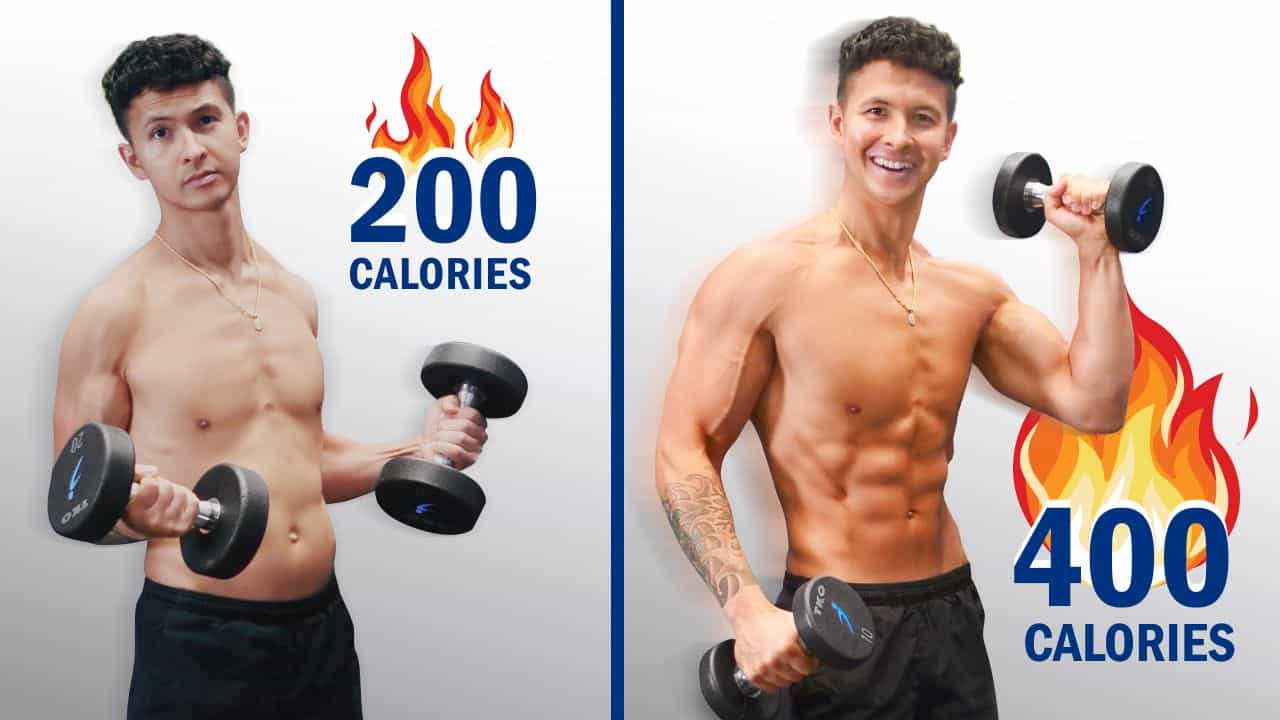
How To Burn More Calories Lifting Weights (Do These 3 Things)
Did you know that it's possible to increase the number of calories you burn through strength training? In fact, there are 3 things you could do - right now - to boost your calorie burn. I show you what they are here.
Lifting weights is great for building muscle. But when it comes to burning calories? Not so great. In this article, I'll explain how that affects your ability to build muscle and lose fat. And then cover the 3 tweaks you can make to increase the number of calories you burn during your lifting workouts. By the end, you'll have a full-body workout that you can get started with right away.
By the way: these are the exact key points (plus more!) accounted for in every single Built With Science program, no matter if it is a home-based or gym-based routine. I’ve designed all training programs to help transform your physique in the most time-efficient manner. And best of all? It’s all rooted in science. For more information:
Click the button below to take my analysis quiz to discover the best program for you:
↓
Combine Both Resistance Training And Cardio For Best Fat Loss Results
First of all. It's important to understand that exercise, alone, isn't very effective for fat loss if your diet is not under control.
For example, it would take you nearly 2 hours of running to burn off the calories from a cheeseburger and small fries! This is very practical.
But with a proper diet, adding the right type of exercise to it can significantly speed up your results.
A 2012 study that involved 119 participants illustrated this point extremely well. Researchers compared the fat loss effects between 3 scenarios:
- Cardio + Dieting
- Resistance training + Dieting
- Cardio + Resistance training + Dieting
Each group ate 2,000 calories a day. The cardio group went jogging for 45 minutes 3 times a week. The resistance training group lifted weights for an hour 3 times a week (60 minutes per session). Whereas the last group did both of these throughout the week.
After several months of this, the researchers analyzed how much fat each group lost:
- Cardio + Dieting: Half a pound of fat
- Resistance training + Dieting: Lost almost 5 times as much as the 'Cardio + Dieting' group
- Cardio + Resistance training + Dieting: Experienced the most fat loss

Cardio Burns More Calories, But Resistance Training Is Crucial For Muscle Mass
Now, what's the reason for these results? Well, it's simply that resistance training doesn't burn as many calories when compared to cardio. Research has shown that, on average, lifting weights burns about 2-3 calories/minute. For reference: a simple brisk walk burns more calories than this, coming in at 4 calories per minute.
Meaning? A single cardio session can easily burn 2-3 times more calories than a traditional resistance training workout does.
However, resistance training does have an important advantage over cardio. The study showed that doing cardio alone led to a small amount of muscle loss. Resistance training, on the contrary, led to an almost 2.5 lb increase in muscle.

This is important to note. Because muscle is what will help keep your metabolism high as you lose weight, and will ensure you end up looking:
- Lean and muscular, NOT
- Just "skinny"
... After a diet.
So. Ultimately, if you're looking for the best fat loss and muscle building results, a combination of resistance training with cardio is best. But ... let's face it. For most people, this is a big commitment. And there's also the fact that traditional cardio can be quite unenjoyable.
Luckily, there's a better option. And that is to combine both cardio and strength training into a single, high-intensity workout! A workout that gives the calorie-burning efficiency of cardio as well as the muscle-building benefits of lifting.
I’ll show you exactly how to do this with three tweaks. And then give you an example workout that puts it into practice.
How To Burn More Calories Through Strength Training
#1: Less Weight, More Reps
The first tweak that'll enable you to burn more calories through lifting weights is by manipulating:
- How much weight you'll be lifting AND
- How many reps you'll be doing in your sets
... For each exercise.
A 2011 study analyzed the calories burned during sets of the bench press by having participants either do sets with:
- Heavier weights for fewer reps OR
- Lighter weights for more reps
The findings? Well, the researchers found that the participants could nearly double the number of calories they burned in a set by lifting lighter weights for more reps.
That said ... while, yes, we can burn slightly more calories the lighter in weight we go, there are 2 scientific findings we need to keep in mind to avoid making the workout less effective on the muscle-building front:
- 2020 analysis: This analysis of several studies found that you could indeed build the same amount of muscle using either light weights or heavy weights. But there's a condition for this. It's only possible if the participants pushed themselves hard enough during their sets to the point where they could only do 1 or 2 more reps if they went all out.
- 2021 paper: In support of the findings of the 2020 analysis mentioned above, this paper found that you can build as much muscle with lighter weights (as with heavier weights). More importantly, though, it highlighted that there's a point where the weight becomes too light. And, thus, becomes less effective for muscle growth.
In light of this, a good recommendation for you is to use a weight that's between 40-60% of the maximum weight you could lift for that exercise. This will help give you the best muscle-building results while still enabling you to burn more calories in a single session.
For most people, this means choosing a weight that you could do around 15-30 reps with. Just remember: you still need to push yourself hard enough for this to be effective.
#2: Increase Muscle Mass Used
The second tweak to burn more calories through lifting weights is to use as much muscle mass as possible within your workouts.
Note that this is something we implement into my Built With Science programs - because of the several benefits it provides. So, if you're interested in burning as many calories as possible through your workouts in a safe and effective manner:
Click the button below to take my analysis quiz to discover the best program for you:
↓
A 2017 study that tested a variety of resistance training exercises, then compared the calorie burn of each, showcases this point. More specifically, the study compared between several:
- "Isolation exercises": These only work one small muscle at a time
- "Compound exercises": These work several different muscles simultaneously
The researchers found that lat pulldowns, which work several back muscles, along with the biceps, burned almost 20% more calories than bicep curls. They also found that squats, which work the whole lower body, burned almost 35% more calories than leg extensions - which only work the quads.
As such, we'll apply this to our "burn more calories" strength training workout by filling the routine with "big exercises". These will be exercises that will work every single muscle of our bodies.
#3: Implement Circuits
Finally, the most important thing you can do to increase the calorie burn of lifting weights is to improve your time efficiency.
Think about it. During a 60-minute resistance training workout, you don’t actually spend much time working. Much of it is spent resting, letting your muscles recover before the next set. This is great if you are trying to maximize muscle growth and strength. But it just isn't very helpful for burning calories.
There is, however, a way that we can structure our workouts to increase our calorie burn without sacrificing gains.
A 2011 study showcased just how effective this method can be. The researchers took a group of trained men and randomized them into 2 groups:
- Group 1: Performed a traditional resistance training workout that involved 3 minutes of rest between each set, and moving through each exercise one at a time.
- Group 2: Performed a circuit style of training. They performed each exercise one right after the other, taking just 30 seconds to transition to the next exercise. They then repeated the circuit for the same total number of sets as the traditional group.
After 8 weeks of this, the researchers found that both groups experienced similar increases in muscle mass and strength. But the circuit training group had a significant decrease in body fat percentage - while the traditional training group did not.
This occurred even with the circuit group training for just half the time of the traditional group (66 vs 115 minutes).
Using this method will enable us to add more exercises and sets into our workout without having to stay in the gym any longer than normal. But we will want to be careful with the exercise selection. We need to ensure we don’t compromise our gains by overworking the same muscle groups with insufficient rest.
A Circuit-Style Workout That'll Help You Burn More Calories
Alright. Now that we've got the science down, let's apply it into a workout that can be done either at a gym or even at home, with just dumbells.
The workout includes 3 circuits that each have 4 exercises.
Within each circuit, you will progress from one exercise to the next resting for only 15-20 seconds.
For each exercise, pick a weight that you could do somewhere between 15-30 reps with if you pushed hard. If you reach above 30 reps, then you know it’s time to use a heavier weight.
Finally, the number of times you perform each circuit depends on your lifting experience:
- Beginner: Perform each circuit 2-3 times
- Intermediate: Perform each circuit 3-4 times
- Advanced: Perform each circuit 4-5 times
Now, let's dive into the first circuit.
Circuit 1: Upper Body
DB Bench Press → DB Row → DB Shoulder Press → Reverse Crunch

The first circuit will focus on the upper body. And all you’ll need is a bench and two pairs of dumbbells.
First, start with the flat dumbbell bench press to work the chest and triceps. If you don’t have a bench, these can just be done on the floor.
Once you finish your set, using the same pair of dumbbells, move onto a bent-over dumbbell row to now work your back and biceps. Keep your back parallel to the floor and pull the dumbbells into your hips, not your chest.
After you finish rows, take a quick breather. Then grab a second set of dumbbells. You’ll want these to be a little lighter.
We’ll use them to perform shoulder presses. We’ll do this standing to slightly boost shoulder muscle activation when compared to the seated version.
The standing dumbbell press has been shown in a 2013 EMG analysis to elicit:
- 8% greater front delt activation
- 15% greater lateral delt activation
- 24% greater rear delt activation
... Compared to the seated version.
When you’re done with this, set the dumbbells down. And we’ll now focus on working the core with reverse crunches. Take it slow and feel your abs working every part of the rep.
After that, you’ve completed 1 round. Take 15-20 seconds to rest and then repeat for the required number of cycles based on your experience level. Once you’re done with circuit 1, take 2-3 minutes to rest and prepare for circuit 2 to now focus on the lower body.
Circuit 2: Lower Body
Goblet Squat→ DB RDL → DB Calf Raise → Weighted Crunch
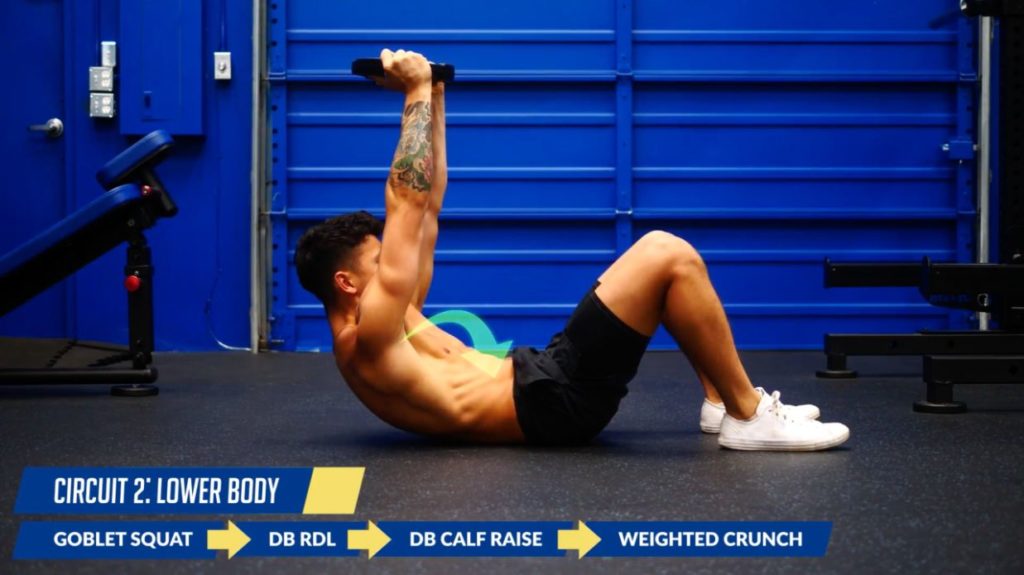
First, we’ll start with a tough yet very effective exercise for the quads. Hold a dumbbell at your chest and squat down at least parallel. Pace yourself here, not going too fast or too slow. Around rep 15 your legs will be on fire but keep pushing.
Once you’re done, grab a pair of dumbbells. And we’ll now focus on the hamstrings and glutes with a Romanian deadlift. Lower the dumbbells as far as you can while keeping your back flat, then use your hamstrings and glutes to pull yourself back up to the starting position.
After this, keeping the same dumbbells, we’ll now work the calves. While standing, raise up on your toes as far as you can, squeeze hard at the top, then control the weight back down and repeat.
We’ll then finish this circuit off with some core work. Grab a 10-25 lb plate, lie on your back, and perform weighted crunches. You don’t need to sit all the way up, just think about trying to touch your chest towards your belly button. Once you’re done, take about 15-20 seconds to rest. And then it’s back to squats.
When you are all done with your required number of circuits, take 2-3 minutes to rest and get ready for the final circuit.
Circuit 3: Full Body
Reverse Lunges → Push Up→ DB Facepulls → Plank
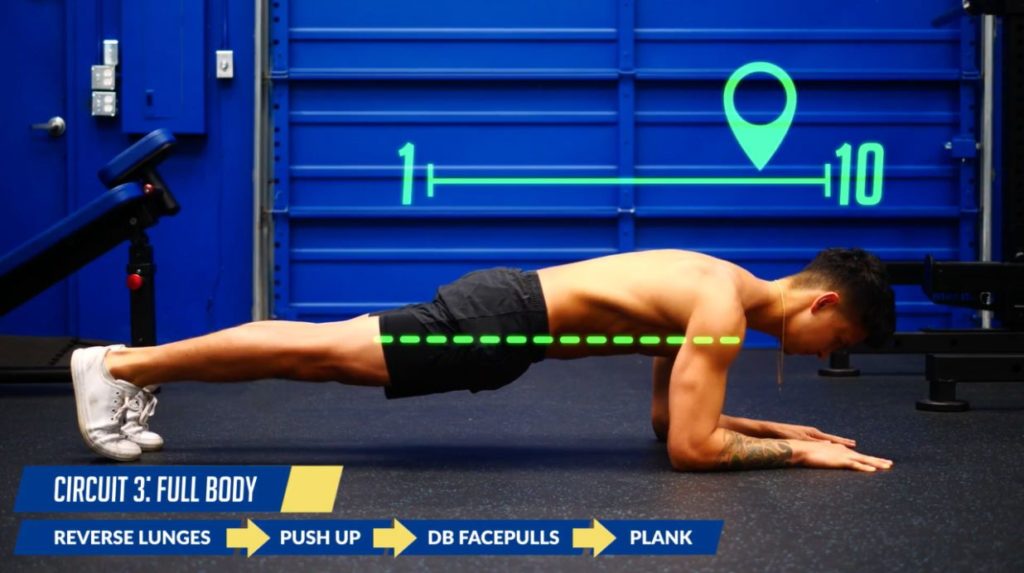
The third and final circuit focuses on the full body. And all you need is a heavier and lighter pair of dumbbells.
First, we’ll work the lower body. With the heavier dumbbells held by your sides, take a step back into a reverse lunge. Keep your chest up, and push up with the front leg. Alternate legs for each rep.
After this, drop down for push-ups. Depending on your experience level, you can elevate your hands on a box to make it easier or elevate your feet to make it harder. What is most important is that you’re pushing yourself hard and getting no more than 30 reps.
After this, grab your lighter pair of dumbbells and we’ll now focus on the mid-back and rear delts. Bend over, then raise your arms into a “W” position at the top. Hold this briefly, then come back down for another rep.
Finally, finish this circuit off with a plank. Squeeze your glutes together and keep your chest and hips parallel to the floor. Don't worry about reps. Just hold it until you get to an 8 or 9/10 difficulty.
Just like the last two circuits, cycle through these exercises 2-5 times depending on your experience level. After that, give yourself a pat on the back, and congratulate yourself for hopefully making it through.
Takeaway
You’ll get the most benefit from this workout if you implement it no less than 2 but no more than 4 times a week. That being said, I wouldn’t use this style of workout if your main goal is to build muscle and improve your strength. I have written up past articles that are more suited for that:
- Strength vs. Hypertrophy Differences
- How To Build Muscle Fast
- Most Effective Way To Master The Pull Up
And for those looking for an all-in-one step-by-step program that’s personalized specifically for your body and your fitness goals, you can take our free quiz over at builtwithscience.com and we’ll determine which program is right for you.
And for those looking for an all-in-one step-by-step program that’s personalized specifically for your body and your fitness goals, you can take our free quiz below and we’ll determine which program is right for you:
Click the button below to take my analysis quiz to discover the best program for you:
↓


